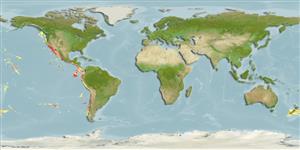>
Alepocephaliformes (Slickheads and tubeshoulders.) >
Platytroctidae (Tubeshoulders)
Etymology: Mirorictus: Latin, mirus = wonderful + Latin, rictus = open mouth (Ref. 45335); taningi: Named for Å. Vedel Tåning.
Eponymy: Dr Åge Vedel Tåning (1890–1958) was a Danish ichthyologist and an expert on lanternfish. [...] (Ref. 128868), visit book page.
Environment: milieu / climate zone / depth range / distribution range
Écologie
marin bathydémersal; profondeur ? - 1750 m (Ref. 40966). Deep-water
Eastern Pacific: Gulf of Panama.
Taille / Poids / Âge
Maturity: Lm ? range ? - ? cm
Max length : 13.7 cm TL mâle / non sexé; (Ref. 40778)
Description synthétique
Clés d'identification | Morphologie | Morphométrie
Dorsal fin rays 18.5; anal 17.5. Branchiostegal rays 4. Pyloric caeca 5. Gill rakers at first arch 5 + 1 + 12, the longest about 3% SL. Longitudinal scale series about 66 scales from the top of the gill slit to caudal base.
Life cycle and mating behavior
Maturité | Reproduction | Frai | Œufs | Fécondité | Larves
Parr, A.E., 1947. A new genus of deepsea fish from the Gulf of Panama. Copeia 1947(1):59-500. (Ref. 40778)
Statut dans la liste rouge de l'IUCN (Ref. 130435: Version 2024-2)
Menace pour l'homme
Harmless
Utilisations par l'homme
Outils
Articles particuliers
Télécharger en XML
Sources Internet
Estimates based on models
Preferred temperature (Ref.
123201): 4.5 - 9.2, mean 5.7 °C (based on 27 cells).
Phylogenetic diversity index (Ref.
82804): PD
50 = 1.0000 [Uniqueness, from 0.5 = low to 2.0 = high].
Bayesian length-weight: a=0.01122 (0.00514 - 0.02450), b=3.04 (2.87 - 3.21), in cm total length, based on all LWR estimates for this body shape (Ref.
93245).
Niveau trophique (Ref.
69278): 3.3 ±0.5 se; based on size and trophs of closest relatives
Résilience (Ref.
120179): Milieu, temps minimum de doublement de population : 1,4 à 4,4 années (Assuming tmax>3).
Fishing Vulnerability (Ref.
59153): Low vulnerability (10 of 100).
